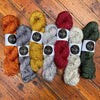Traditional wool felts when you wash it in a machine. This is a fact of modern life. On the upside, there is a process that can be done so that it doesn't felt! On the downside, that process usually involves terrible chemicals. Here's a mile-high look at some of the main considerations about superwash wool.
WHAT AND WHY
Untreated, regular wool must be hand-washed because it felts when machine-washed... or sometimes even hand-washed with hot water and vigorous agitation. It does this because of naturally-occurring scales on the wool fiber that snag like velcro when they rub against one another in a warm, humid environment (hello, washing machine!). The superwash process removes or fills in or covers the scales, making machine-washing less likely to cause the sticking action that leads to felting.
PROS
Especially if you are knitting or crocheting for babies and kids, being able to machine-wash a finished object is sometimes NECESSARY. Superwash wool retains most of the other characteristics of wool (memory, bounce, warmth even when wet) while allowing it to be washed.
For many folks, superwash also reduces the dreaded itch factor of wool. That's because smoothing over those miniature scales can make it feel smoother on your skin, too. We still recommend testing the yarn before using it, but for those with a sensitivity instead of a true wool allergy, superwash can do the trick.
Superwash also makes possible vivid colors that dyers, and consumers, love. Those luscious, vibrant colors are often what attacts us Twistedistas to a superwash wool!
CONS
Superwash can make projects grow when blocked. In this case, you're not getting the benefit of the fiber sticking to itself naturally. Always wash and block your swatch!
Similarly, eliminating the scales in the fiber removes some of the air that makes wool bouncy and fluffy. This makes garments in superwash yarn heavier and denser, as well as less elastic.
Finally, two words: toxic chemicals. There are companies trying to develop a better process (O-Wool is one), but for now most superwash yarn is either treated in a chlorinated acid bath or coated with a polyamide and/or nylon that can be highly toxic. Or both. The environmental and concomitant social impacts can be pretty raunchy, as with many, many, many modern conveniences and manufacturing processes. There is a lot of info out there about this issue and different perspectives on it. Just one example is a rad two-part blog post from Mason-Dixon Knitting. If you're concerned about the environmental aspect of superwash wool (we are based in Portland, Oregon, after all!) we encourage you to learn all you can. Knowledge is power!
THE BOTTOM LINE
It really comes down to your project, your budget, and how strongly you feel about the environmental concerns. Sometimes, washability and color mean there is really only one option. On the other hand we've heard some customers say that, for them, superwash wool is no longer truly wool at all, and nothing but the original classic will do. As always, we encourage you to ponder your options and pick the right yarn for yourself and your projects!









